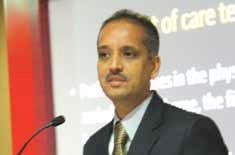
Diagnostics, Point-of-Care Technologies & Chronic Disease Management
 Though the challenges of providing high quality healthcare in developing countries are different than those in developed countries, there is a common goal to provide access to health monitoring and assessment technologies to people with limited or no healthcare facilities. Here Diagnostics, Pointof- Care Technologies & Chronic Disease Management play an important role.
Though the challenges of providing high quality healthcare in developing countries are different than those in developed countries, there is a common goal to provide access to health monitoring and assessment technologies to people with limited or no healthcare facilities. Here Diagnostics, Pointof- Care Technologies & Chronic Disease Management play an important role.

Technological advancement in laboratory mediicine

Sanjeev Vashishta
CEO,
SRL Ltd

Primary objective towards which we strive is to make a patient painless whenever he comes for treatment. It may not be incorrect to state that lab medicine is the nerve centre of all medicine. About 70 to 80 percent of the medical decisions are based on lab medicine results and outcomes. The three aspects I have mentioned earlier i, e. timely care, good quality care are something we are striving for. These three aspects have to be covered not just for giving quality care to the people but also to keep the competition at bay. One more aspect is rapidity or quick turnaround. So the idea is to get the test done at the first point of contact and the logistics build around in a manner that you are able to turnaround the test results in an early time and second is the accuracy. The accuracy is depended over multiple factors, one is what the processes you have laid down, what kind of team you have, skill set you have what kind of technology you are using so these are four things which will enable you to get the accuracy in the outcome of the test results and lastly is the value for money which is very individualistic in the mind of user and value of money is something which has to be given.
Mobile MIM is the first FDA cleared application

Dr N Eshwar Chand
Chief Radiologist,
Kamineni Hospitals,
Hyderabad,
General Secretary, IRIA,
Andhra Pradesh
Pocket ultrasound is the new addition for diagnostics of particular disease. Previously all radiologists used to work on workstations but now hand-held devices; smart phones and the tablets have dominated the market. Mobile MIM
is the first FDA-cleared app for diagnostic interpretation of medical images on mobile devices. Mobile MIM supports the viewing of CT, MRI and nuclear medicine scans. Here, public private partnership can help us in providing point-ofcare to remote and underserved areas. Point-of-care technology and wireless networks are fit like hand in glove in healthcare and use of the network is poised for growth. Wireless technologies also have added to the ease. Instead of clinicians going where data is, data is now going where the clinician is. There are a few disadvantages of point-of-care testing. Sometimes its inferior to central testing; the cost can sometime be more than what is done in the central laboratory.The satisfaction levels could be less for the patients as well as for the trading physician and not all devices or all tests are validated universally. So in conclusion it can be said that the point of care testing is way to go.
Diagnostics is at the threshold of endless possibilities

Reena Nakra
Head M&A,
Dr Lal Path Labs Pvt Ltd
By 2015, we believe chronic patients will be empowered to take control of their diseases through IT-enabled disease management programmes that improve outcomes and lower costs. Their treatment will center on their location, thanks to connected home monitoring devices, which will automatically uate data and when needed, generate alerts and action recommendations to patients and providers. IT will enable us to leverage the scarce or specialised clinical resources through telemedicine. Home monitoring devices, such as scales, glucometers, and blood pressure cuffs, will automatically transfer daily values to electronic personal health records (PHRs). The combination of the PHR, where patients record information, the electronic health record (EHR), where providers record information, and their linkage to clinical knowledge bases and rules engines, which will automatically uate data and generate alerts and action recommendations to the patient and appropriate providers, will transform chronic care management and reduce the need for acute interventions.
Point-of-Care Test (POCT) reduces Thematic Apperception Test (TAT), makes it possible for physicians to receive test results of critically ill patients in real time. Decentralisation of diagnostic testing, from the lab to the immediate vicinity of the patient, is facilitated through point of care diagnostics. They have significantly impacted diagnosis of
diseases such as Malaria and HIV. However, Remote Diagnostic Technologies (RDT) still have limitations of sensitivity and specificity for many conditions and hence, further refinement is required in this technology.
Be a part of Elets Collaborative Initiatives. Join Us for Upcoming Events and explore business opportunities. Like us on Facebook , connect with us on LinkedIn and follow us on Twitter , Instagram.









